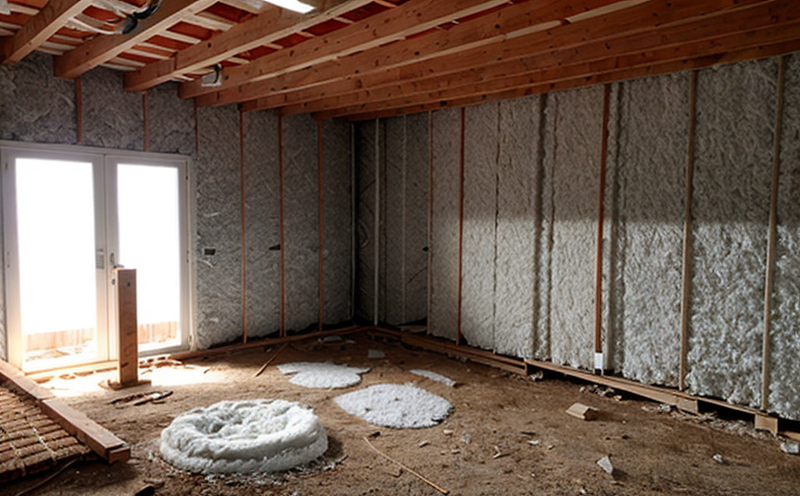Insulation resistance inspection
The integrity of electrical and electronic systems is paramount in ensuring their safety, reliability, and longevity. Insulation resistance (IR) plays a critical role in this regard by preventing the flow of current through unintended paths, thereby protecting both personnel and equipment from damage due to faults or improper connections.
Insulation resistance inspection involves measuring the electrical resistance between two conductors that are electrically isolated but connected together. This process helps identify potential issues before they escalate into failures that could compromise system integrity. The measurement is typically done using a high-voltage DC source and an ammeter to determine how much current flows through the insulating material.
In the context of electrical and electronic systems, this inspection ensures compliance with international standards such as ISO 17825:2014, which provides guidelines for the testing of insulation resistance in medical devices. Proper IR measurement also aligns with EN 62393-2, which covers safety requirements for electrically operated home appliances and similar products.
The process begins by selecting an appropriate test voltage based on the type of equipment being inspected. For instance, medical devices often require testing at 500V DC, while industrial machinery might necessitate higher voltages up to 1000V DC or more. Specimen preparation involves disconnecting any non-insulating elements and cleaning surfaces to ensure accurate readings.
Once prepared, the test is conducted using specialized equipment capable of delivering controlled voltage levels. After application, the current flowing through the insulation is measured over a specified period (usually 1 minute). The resulting resistance value indicates the effectiveness of the insulation protection provided by the system.
Interpreting these results involves comparing them against established thresholds defined in relevant standards. If the measured IR falls below acceptable levels, it signals the presence of degraded or compromised insulating materials, prompting further investigation and possibly repair actions.
The importance of regular IR inspections cannot be overstated, especially given modern trends towards more complex electrical systems integrated into various sectors including healthcare, automotive, consumer electronics, and industrial automation. By proactively addressing any detected weaknesses early on, organizations can prevent costly downtime, reduce risks associated with electrical hazards, and enhance overall product quality.
For instance, in the medical industry, ensuring proper IR levels is crucial not only for maintaining patient safety but also for regulatory compliance purposes. Similarly, within automotive manufacturing plants, consistent application of this practice guarantees robust performance across diverse environmental conditions experienced during vehicle operation.
Why It Matters
Insulation resistance inspection is essential because it directly impacts the safety and reliability of electrical and electronic systems. Poorly insulated components can lead to short circuits, fires, or even explosions if not addressed promptly. These risks are particularly significant in high-risk environments such as hospitals where equipment failures could result in severe consequences.
From a practical standpoint, regular IR inspections help extend the lifespan of critical infrastructure by identifying and mitigating vulnerabilities before they become major problems. This proactive approach saves time and resources compared to reactive repairs after an incident has occurred.
- International Standards: Compliance with recognized standards ensures that products meet global safety requirements and can be trusted across various markets.
- Regulatory Requirements: Many industries have specific regulations mandating regular IR testing as part of their quality assurance programs. Non-compliance may lead to penalties or bans on product sales.
- Risk Management: Implementing robust IR inspection protocols forms an integral component of comprehensive risk management strategies aimed at protecting assets and ensuring operational continuity.
In summary, investing in insulation resistance inspections offers tangible benefits beyond mere compliance. It fosters a culture of continuous improvement, enhances reputation among stakeholders, and ultimately contributes to sustainable business growth.
Quality and Reliability Assurance
The quality and reliability assurance provided by thorough IR inspection are foundational elements in maintaining optimal system performance throughout their lifecycle. By detecting early signs of degradation or damage within the insulating materials, these inspections enable timely corrective measures that prevent potential failures.
A key aspect of this assurance lies in preventing catastrophic events such as electrical shorts or open circuits which can disrupt normal operations and potentially cause harm. Through precise measurement techniques and adherence to stringent criteria outlined in relevant standards, professionals can ensure consistent performance across different environments and applications.
Moreover, implementing effective IR inspection procedures helps establish trust between manufacturers and end-users by demonstrating commitment to excellence through rigorous testing practices. Such transparency builds long-term relationships based on mutual respect and shared goals towards superior outcomes.
Incorporating advanced technologies like automated data collection systems further enhances the accuracy and efficiency of IR inspections. These tools not only reduce human error but also allow for real-time monitoring and reporting, enabling swift decision-making processes when issues arise.
Ultimately, prioritizing quality and reliability assurance through comprehensive IR inspections translates into enhanced customer satisfaction, reduced maintenance costs, increased asset utilization rates, and ultimately drives competitive advantage within the marketplace.
International Acceptance and Recognition
- ISO Standards: ISO 17825:2014 specifies requirements for electrical insulation resistance testing in medical devices, ensuring consistent practices worldwide.
- EN Standards: EN 62393-2 sets forth safety requirements for electrically operated home appliances and similar products, mandating appropriate IR testing procedures.
- ASTM Guidelines: ASTM F1508 provides recommendations on how to conduct insulation resistance tests on electrical connectors, promoting uniformity across various sectors.
- IEC Publications: IEC 62394 outlines methods for assessing the electrical safety of medical electrical equipment and associated systems, emphasizing the importance of IR measurements.
These international standards underscore the universal acceptance and recognition accorded to rigorous insulation resistance inspections. Compliance with these guidelines ensures that products meet stringent quality benchmarks, fostering trust among consumers and stakeholders alike while facilitating seamless market entry into diverse geographical regions.
The widespread adoption of such practices highlights their significance in promoting best-in-class manufacturing processes globally. By adhering to these internationally recognized norms, manufacturers can confidently demonstrate their commitment to excellence, thereby enhancing brand reputation and fostering sustainable growth across the industry spectrum.





